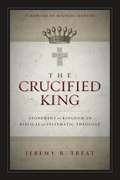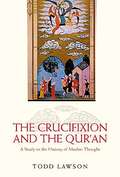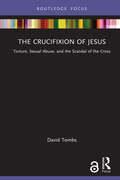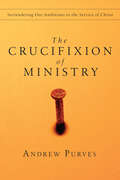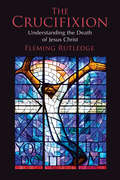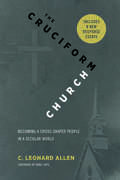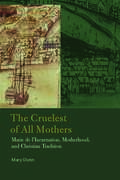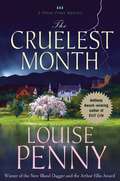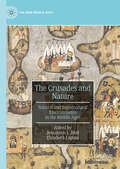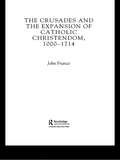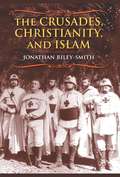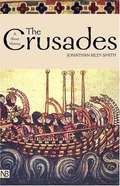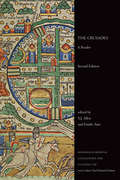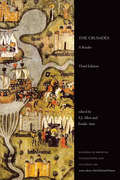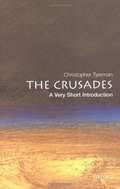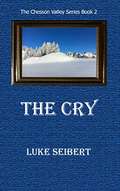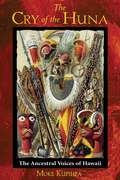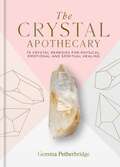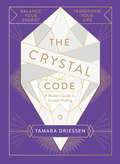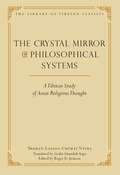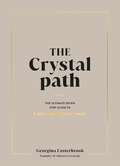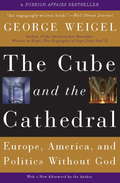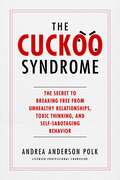- Table View
- List View
The Crucified King: Atonement and Kingdom in Biblical and Systematic Theology
by Jeremy R. Treat Michael HortonThe kingdom of God and the atonement are two of the most important themes in all of Scripture. Tragically, theologians have often either set the two at odds or focused on one to the complete neglect of the other. In The Crucified King, Jeremy Treat demonstrates that Scripture presents a mutually enriching relationship between the kingdom and atonement that draws significantly from the story of Israel and culminates in the crucifixion of Christ the king. As Israel’s messiah, he holds together the kingdom and the cross by bringing God’s reign on earth through his atoning death. The kingdom is the ultimate goal of the cross, and the cross is the means by which the kingdom comes. Jesus’ death is not the failure of his messianic ministry, nor simply the prelude to his royal glory, but is the apex of his kingdom mission. The cross is the throne from which he rules and establishes his kingdom. Using a holistic approach that brings together the insights of biblical and systematic theology, this book demonstrates not only that the kingdom and the cross are inseparable, but how they are integrated in Scripture and theology.
The Crucifixion and the Qur'an: A Study in the History of Muslim Thought
by Todd LawsonAccording to the majority of modern Muslims and Christians, the Qur'an denies the crucifixion of Jesus, and with it, one of the most sacred beliefs of Christianity. However, it is only mentioned in one verse and contrary to popular belief, its interpretation has been the subject of fierce debate among Muslims for centuries. This innovative work is the first book devoted to the issue, delving deeply into largely ignored Arabic sources, which suggest that the origins of the denial may lie within the Christian Church. Arranged along historical lines, and covering various Muslim schools of thought, from Sunni to Sufi, The Crucifixion and the Qur'an will fascinate anyone interested in Christian-Muslim relations. Todd Lawson is Associate Professor at the Department of Near and Middle Eastern Civilizations, University of Toronto. He is the author of Reason and Inspiration in Islam: Theology, Philosophy and Mysticism in Muslim Thought.
The Crucifixion of Jesus: Torture, Sexual Abuse, and the Scandal of the Cross (Rape Culture, Religion and the Bible)
by David TombsRoman crucifixions sought to degrade and dehumanise their victims in ways that destroyed their dignity and stigmatised their memory. Paul speaks of the cross as a ‘scandal’ or ‘stumbling block’, but the significance of this language has never been explored in terms of sexual violence. The Crucifixion of Jesus examines crucifixion as a form of torture, state terror, and sexual abuse. It reads recent accounts of torture alongside the presentation of crucifixion in the Passion narratives and other Greek and Roman sources. Outlining compelling reasons for viewing Jesus as a victim of sexual abuse, it examines why this unsettling aspect of the narrative has remained ‘hidden in plain sight’ for so long, and what place it might have in discussions of rape culture past and present. It also asks whether other acts of sexual violence and rape might have happened during the mockery in the praetorium, or even on the cross itself. It argues that although the acknowledgement of this ‘unspeakable violence’ is deeply disturbing, breaking the silence can nonetheless have constructive consequences. In addition to offering a more historical understanding of crucifixion, this book illuminates positive new aspects of resurrection, making it a probing read for scholars of biblical studies and for those interested in the interplay of religion and violence.
The Crucifixion of Ministry: Surrendering Our Ambitions to the Service of Christ
by Andrew PurvesAs a pastor, do you ever get the feeling that no matter what you try, nothing much seems to change? That is because the ministries themselves are not redemptive--they are not up to you. Only Jesus' ministry is redemptive. Jesus has to "show up." Theologian Andrew Purves explores at the deepest level the true and essential nature of Christian ministry. He says that the attempt to be an effective minister is a major problem. Ministers are "in the way." He radically claims that ministries need to be crucified. They need to be killed off so that Christ can make them live. Rooting church service in Christ's own continuing ministry, Purves provides a vision for students and practicing clergy to reclaim the vital connection between Christ and participation in his ministry today, even if it means letting Christ put to death the ministries to which pastors cling so closely. A radical appraisal for a critical malady affecting the life of the Christian church written in plain, down-to-earth language.
The Crucifixion: Understanding the Death of Jesus Christ
by Fleming RutledgeThough the apostle Paul boldly proclaimed &“Christ crucified&” as the heart of the gospel, Fleming Rutledge notes that preaching about the cross of Christ is remarkably neglected in most churches today. In this book Rutledge addresses the issues and controversies that have caused pastors to speak of the cross only in the most general, bland terms, precluding a full understanding and embrace of the gospel by their congregations. Countering our contemporary tendency to bypass Jesus&’ crucifixion, Rutledge in these pages examines in depth all the various themes and motifs used by the New Testament evangelists and apostolic writers to explain the meaning of the cross of Christ. She mines the classical writings of the Church Fathers, the medieval scholastics, and the Reformers as well as more recent scholarship, while bringing them all into contemporary context. Widely known for her preaching, Rutledge seeks to encourage preachers, teachers, and anyone else interested in what Christians believe to be the central event of world history.
The Crucifixion: Understanding the Death of Jesus Christ
by Fleming RutledgeThough the apostle Paul boldly proclaimed &“Christ crucified&” as the heart of the gospel, Fleming Rutledge notes that preaching about the cross of Christ is remarkably neglected in most churches today. In this book Rutledge addresses the issues and controversies that have caused pastors to speak of the cross only in the most general, bland terms, precluding a full understanding and embrace of the gospel by their congregations. Countering our contemporary tendency to bypass Jesus&’ crucifixion, Rutledge in these pages examines in depth all the various themes and motifs used by the New Testament evangelists and apostolic writers to explain the meaning of the cross of Christ. She mines the classical writings of the Church Fathers, the medieval scholastics, and the Reformers as well as more recent scholarship, while bringing them all into contemporary context. Widely known for her preaching, Rutledge seeks to encourage preachers, teachers, and anyone else interested in what Christians believe to be the central event of world history.
The Cruciform Church, Annivesary Edition: Becoming a Cross-Shaped People in a Secular World
by Mike Cope Raymond Carr Randy Harris Richard Beck Jonathan Storment John Mark Hicks Scot McKnight C. Leonard Allen Sara Barton Lee CampWhat is left of the Gospel if you take away the cross?This central question, asked by C. L. Loos but tucked away in a nineteenth-century journal, launched The Cruciform Church twenty-five years ago. Read by a generation of ministers and church leaders, The Cruciform Church began a reimagination of the church in our increasingly, secular age.Now updated, with responses from eight key leaders, this contemporary classic aims to reach a new generation with the critical questions of faith and life.New Responses by:- Sara Barton - Richard Beck - Lee Camp - Raymond Carr - Randy Harris - John Mark Hicks - Scot McKnight - Jonathan Storment
The Cruelest of All Mothers: Marie de l'Incarnation, Motherhood, and Christian Tradition (Catholic Practice in North America)
by Mary DunnIn 1631, Marie Guyart stepped over the threshold of the Ursuline convent in Tours, leaving behind her eleven-year-old son, Claude, against the wishes of her family and her own misgivings. Marie concluded, “God was dearer to me than all that. Leaving him therefore in His hands, I bid adieu to him joyfully.” Claude organized a band of schoolboys to storm the convent, begging for his mother’s return. Eight years later, Marie made her way to Quebec, where over the course of the next thirty-three years she opened the first school for Native American girls, translated catechisms into indigenous languages, and served some eighteen years as superior of the first Ursuline convent in the New World. She would also maintain, over this same period, an extensive and intimate correspondence with the son she had abandoned to serve God.The Cruelest of All Mothers is, fundamentally, an explanation of Marie de l’Incarnation’s decision to abandon Claude for religious life. Complicating Marie’s own explication of the abandonment as a sacrifice carried out in imitation of Christ and in submission to God’s will, the book situates the event against the background of early modern French family life, the marginalization of motherhood in the Christian tradition, and seventeenth-century French Catholic spirituality. Deeply grounded in a set of rich primary sources, The Cruelest of All Mothers offers a rich and complex analysis of the abandonment.
The Cruellest Month (Chief Inspector Gamache #3)
by Louise Penny"Many mystery buffs have credited Louise Penny with the revival of the type of traditional murder mystery made famous by Agatha Christie .... The book's title is a metaphor not only for the month of April but also for Gamache's personal and professional challenges--making this the series standout so far. " --Sarah Weinman Welcome to Three Pines, where the cruelest month is about to deliver on its threat. It's spring in the tiny, forgotten village; buds are on the trees and the first flowers are struggling through the newly thawed earth But not everything is meant to return to life. . . When some villagers decide to celebrate Easter with a séance at the Old Hadley House, they are hoping to rid the town of its evil--until one of their party dies of fright. Was this a natural death, or was the victim somehow helped along? Brilliant, compassionate Chief Inspector Armand Gamache of the Sûreté du Québec is called to investigate, in a case that will force him to face his own ghosts as well as those of a seemingly idyllic town where relationships are far more dangerous than they seem.
The Crusades and Nature: Natural and Supernatural Environments in the Middle Ages (The New Middle Ages)
by Elizabeth Lapina Jessalynn L. BirdThe Crusades and Nature: Natural and Supernatural Environments in the Middle Ages explores the intersection of crusader studies and studies of nature. The volume addresses encounters with, responses to and representations of a broad variety of phenomena: celestial objects and events; familiar and unfamiliar fauna and flora; seascapes and landscapes; the elements and the seasons; etc. It introduces readers to crusaders’ actual, but also largely or entirely imaginary encounters with natural phenomena, as well as literary references to nature in crusader sources more generally (such as, for example, animal metaphors). Finally, this project investigates the relationships between the natural and the supernatural and between nature and human-made environments. The volume will define “crusades” broadly, to include not only crusades to the East, but also crusades to frontier regions such as the Baltic and Iberian peninsula and extends to representations of crusades and nature in later medieval and early modern sources.
The Crusades and the Expansion of Catholic Christendom, 1000-1714
by John FranceThe Crusades and the Expansion of Catholic Christendom, 1000-1714 is a fascinating and accessible survey that places the medieval Crusades in their European context, and examines, for the first time, their impact on European expansion. Taking a unique approach that focuses on the motivation behind the Crusades, John France chronologically examines the whole crusading movement, from the development of a ‘crusading impulse’ in the eleventh century through to an examination of the relationship between the Crusades and the imperialist imperatives of the early modern period. France provides a detailed examination of the first Crusade, the expansion and climax of crusading during the twelfth and thirteenth centuries and the failure and fragmentation of such practices in the fourteenth and fifteenth centuries. Concluding with an assessment of the influence of the Crusades across history, and replete with illustrations, maps, timelines, guides for further reading, and a detailed list of rulers across Europe and the Muslim world, this study provides students with an essential guide to a central aspect of medieval history.
The Crusades, Christianity, and Islam
by Riley-Smith JonathanA leading authority on medieval history considers the repercussions of the Crusades in modern times.
The Crusades, Christianity, and Islam (Bampton Lectures in America)
by Jonathan Riley-SmithThe Crusades were penitential war-pilgrimages fought in the Levant and the eastern Mediterranean, as well as in North Africa, Spain, Portugal, Poland, the Baltic region, Hungary, the Balkans, and Western Europe. Beginning in the eleventh century and ending as late as the eighteenth, these holy wars were waged against Muslims and other enemies of the Church, enlisting generations of laymen and laywomen to fight for the sake of Christendom.Crusading features prominently in today's religio-political hostilities, yet the perceptions of these wars held by Arab nationalists, pan-Islamists, and many in the West have been deeply distorted by the language and imagery of nineteenth-century European imperialism. With this book, Jonathan Riley-Smith returns to the actual story of the Crusades, explaining why and where they were fought and how deeply their narratives and symbolism became embedded in popular Catholic thought and devotional life. From this history, Riley-Smith traces the legacy of the Crusades into modern times, specifically within the attitudes of European imperialists and colonialists and within the beliefs of twentieth-century Muslims. Europeans fashioned an interpretation of the Crusades from the writings of Walter Scott and a French contemporary, Joseph-François Michaud. Scott portrayed Islamic societies as forward-thinking, while casting Christian crusaders as culturally backward and often morally corrupt. Michaud, in contrast, glorified crusading, and his followers used its imagery to illuminate imperial adventures. These depictions have had a profound influence on contemporary Western opinion, as well as on Muslim attitudes toward their past and present. Whether regarded as a valid expression of Christianity's divine enterprise or condemned as a weapon of empire, crusading has been a powerful rhetorical tool for centuries. In order to understand the preoccupations of Islamist jihadis and the character of Western discourse on the Middle East, Riley-Smith argues, we must understand how images of crusading were formed in the nineteenth and twentieth centuries.
The Crusades: A History (2nd edition)
by Jonathan Riley-SmithThis lively, comprehensive history provides a wealth of fascinating detail about the Crusades and the politics and personalities behind them. This new edition includes revisions throughout as well as a new Preface and Afterword in which Jonathan Riley-Smith surveys recent developments in the field and examines responses to the Crusades in different periods, from the Romantics to the Islamic world today, making this the standard and authoritative account of the Crusades for years to come. From reviews of the first edition:"Everything is here: the crusades to the Holy Land, and against the Albigensians, the Moors, the pagans in Eastern Europe, the Turks, and the enemies of the popes. Riley-Smith writes a beautiful, lucid prose, . . . [and his book] is packed with facts and action. "--Choice "A concise, clearly written synthesis . . . by one of the leading historians of the crusading movement. "--Robert S. Gottfried,Historian "A lively and flowing narrative [with] an enormous cast of characters that is not a mere catalog but a history. . . . A remarkable achievement. "--Thomas E. Morrissey,Church History "Superb. "--Reuven S. Avi-Yonah,Speculum "A first-rate one-volume survey of the Crusading movement from 1074 . . . to 1798. "--Southwest Catholic
The Crusades: A Reader, Second Edition (Readings In Medieval Civilizations And Cultures Ser. #8)
by Emilie Amt S. J. AllenSince the publication of the first edition of The Crusades: A Reader, interest in the Crusades has increased dramatically, fueled in part by current global interactions between the Muslim world and Western nations. The second edition features an intriguing new chapter on perceptions of the Crusades in the modern period, from David Hume and William Wordsworth to World War I political cartoons and crusading rhetoric circulating after 9/11. Islamic accounts of the treatment of prisoners have been added, as well as sources detailing the homecoming of those who had ventured to the Holy Land—including a newly translated reading on a woman crusader, Margaret of Beverly. The book contains sixteen images, study questions for each reading, and an index.
The Crusades: A Reader, Third Edition (Readings in Medieval Civilizations and Cultures #VIII)
by Emilie Amt S. J. AllenSince its first appearance in 2004, The Crusades: A Reader has been the go-to sourcebook in the field. S.J. Allen and Emilie Amt cover the entire crusading movement, from its origins to its modern afterlife, using key primary source documents. The third edition features a new introduction that includes a guide for students on how to use the book. The editors have also added more content on women, material culture, Jewish and Byzantine perspectives, Muslim-Crusader interactions, and modern use of Crusade imagery and rhetoric by the Far Right. The geographic range is broad, covering not only Crusades in the Middle East, but also in Spain and in northern Europe and against European heretics. While scholarship, courses, and textbooks on the Crusades have proliferated over the past twenty years, The Crusades: A Reader remains the only comprehensive, up-to-date, and in-print sourcebook available on the subject.
The Crusades: A Very Short Introduction
by Christopher Tyerman"This Very Short Introduction, originally published as Fighting in Christendom, presents a clear and lively discussion of the Crusades and the debates and the controversies that surround them. Bringing together issues of colonialism, cultural exchange, and economic exploitation, Tyerman challenges our assumptions about the Crusades and encourages us to re-evaluate the relationship between past and present."--BOOK JACKET.
The Cry (The Chesson Valley Series #2)
by Luke SeibertOver a year has passed since the Civil War erupted, leaving Peter Brenton and the Army of Northern Virginia wearied, broken, and seemingly disillusioned from their invasion into Maryland. They had visions of a quick, easy resolution to the differences between the states, but that dream now has been laid in the grave of the past.As the Union and Confederate armies follow each other’s movements on the opposite sides of the Rappahannock River, the two forces come head to head at the small, quiet community of Fredericksburg. With Richmond only a few dozen miles away, Peter knows that they cannot fail to stop the Union advance. If they would be defeated there, the war would be over in a matter of weeks—but at even greater cost to his home of Virginia. Yet despite his fellow soldiers’ and his own loyalty to their homeland, Peter doubts whether their ragged condition will be able to withstand the Northern onslaught. Outnumbered, underfed, and poorly supplied, they seem to be little match for the Federal army that now opposes them. Will their dogged, Confederate determination be enough for them to hold their position? And with situations beginning to change in his personal life, will he even be able to subject his full attention to that task?
The Cry of the Huna: The Ancestral Voices of Hawaii
by Moke KupiheaExplores the breakdown in the chain of cultural transmission that has led to the decimation of Hawaiian spirituality, and how it can be restored• Shows how reconnection to the ancestral ways can be achieved through letting go and forgiveness of the effects of colonization• Reveals how the lessons of the decline of Hawaiian spiritual tradition reflect on other religions • Clarifies the complex nature of Hawaiian ancestral worshipHawaiian spirituality teaches that individuals can be truly fulfilled only if they are conscious participants in the long ancestral chain of witnessing and transmission that connects the present to the time of origins. The Cry of the Huna invokes the author's personal history as he recounts the decline of his people's spiritual tradition as a result of colonization. The breakdown of the Hawaiians' ties with their sacred land led them to forget not only the teachings of their ancestors, but also the chain of na aumakua they form, which connects this people to both the earth and the realm of the gods. While the na aumakua can be viewed with reverence it is not seen or worshiped as a God. Rather it is seen as a part of the chain of life that arose from one god's vision of creation. Aumakua is a compound of makua (parents) and au, the endless ancestral chain that stretches through time. Each individual on earth represents a temporary end to that chain. As we age and our vision of life slowly looks toward death, our descendents come forth to provide the next eyes in the chain of witnessing and transmission.The Cry of the Huna shows how the rupture of this chain has led to widespread alienation. An endless cycle of resentment and revenge is fueled by the loss of the Hawaiians' spiritual birthright. The connection to the aumakua, however, can be reforged, but only by untying the circular cords of revenge to allow forgiveness to occur in the present so that healing can take place in the future.
The Crystal Apothecary: 75 crystal remedies for physical, emotional and spiritual healing
by Gemma PetherbridgeWhether you are suffering from stress, insomnia, loneliness or heartbreak, or looking to improve your relationships, attract wealth, or let go of your fears, this beautiful reference guide can recommend a crystal to help your cause.With detailed descriptions of 75 crystals, their attributes and powers, information on how to select, cleanse and care for your crystals, and how to put them to use - whether by creating a crystal grid, meditating with your crystal, performing a crystal ritual or preparing an crystal elixir - this book will help you to harness the therapeutic power of crystals to heal yourself and transform your life.Divided into eight main chapters, each relating to a specific area of your life (Your Body, Your Mind, Your Heart, Your Soul, Your Emotions, Your Relationships, Your Obstacles and Your World), this book is inspired by ancient apothecaries of days gone by, which formulated medicines and dispensed healing herbs, while offering a wealth of advice and services to soothe their customers' ailments.An illuminating reminder of the healing power of crystals, The Crystal Apothecary is a book that you will return to again and again for many years to come.
The Crystal Code: A Modern Guide to Crystal Healing
by Tamara DriessenDe-stress, recharge, and tune into your intuition with this indispensable guide to unlocking the power of crystals and creating positive change in your life.More than just sparkly decorations, crystals are ancient objects that possess holistic healing benefits to manifest harmony, health, and connection with ourselves on a deeper level. For crystal healer Tamara Driessen, they've been part of her life since she bought a hunk of rose quartz when she was eight years old. Ever since, she's used crystals to guide and heal herself, and later, others in one-on-one client sessions and sold-out monthly workshops in London. She sees these glittering stones as cosmic technology, absorbing, transforming, and transmitting energy. Within this book she teaches us about the unique properties of 70 potent crystals--each beautifully photographed--and how to work with them, whether you're looking to quiet your mind, enliven your heart, or cleanse your living space. Find out what crystal you can use to: * Boost confidence (peacock ore) * Calm anxiety (pure white celestite) * Feel more centered and in control (purple amethyst) * Get over your ex (rosy pink kunzite)She also includes best practices for cleansing your crystals (for the purest connection possible), programming them (so they know what you want help with), and charging them outdoors (to give them an energy boost from the elements). And whether you're a modern mystic, a newbie collector, or just crystal curious, once you've discovered which crystals are calling to you, Tamara's meditations and rituals for releasing negative energy will help you follow your intuition and shift or center your priorities.
The Crystal Mirror of Philosophical Systems: A Tibetan Study of Asian Religious Thought
by Geshe Lhundub Sopa Roger R. Jackson Thuken Losang NyimaThe Crystal Mirror of Philosophical Systems, by Thuken Losang Chokyi Nyima (1737-1802), is arguably the widest-ranging account of religious philosophies ever written in pre-modern Tibet. Like most Tibetan texts on philosophical systems, this work covers the major schools of India, both Buddhist and non-Buddhist, but then goes on to discuss in detail the entire range of Tibetan traditions as well, with separate chapters on the Nyingma, Kadam, Kagyu, Shije, Sakya, Jonang, Geluk, and Bon schools. Not resting there, Thuken goes on to describe the major traditions of China--Confucian, Daoist, and the multiple varieties of Buddhist--as well as those of Mongolia, Khotan, and even Shambhala. The Crystal Mirror of Philosophical Systems is unusual, too, in its concern not just to describe and analyze doctrines, but to trace the historical development of the various traditions. The Crystal Mirror of Philosophical Systems is an eloquent and erudite presentation exploring the religious history and philosophical systems of an array of Asian Cultures--and offering evidence that the serious and sympathetic study of the history of religions has not been a monopoly of Western scholarship.
The Crystal Path: The Ultimate Seven-Step Guide to Unlocking Your Power with Crystal Healing
by Georgina EasterbrookDiscover how to unlock your true potential through the power of crystals from TikTok superstar @athenascrystals __________ The life of your dreams is within your reach - and you already have what it takes to get it. Georgina Easterbrook, founder of Athena's Crystals and TikTok sensation, is your divine guide who will teach you how to harness the power of crystals and take control of seven key aspects of your life: LOVE MONEY HEALING CONFIDENCE PROTECTION MANIFESTING HAPPINESS Whether it's romantic love, emotional healing, achieving your career goals or manifesting your deepest desires, there is a crystal to help you every step of the way, from the mindful energy of Sodalite to the self-love brought by Rose Quartz. And with Georgina guiding you through every step, you can build a future that aligns with your innermost goals . . .In Spring, use Seraphinite if you're ready for some real change in your life.For the lunar eclipse in Scorpio, dive deep into your emotions with Labradorite, the stone of self-discovery.As we grow towards Summer, use Amazonite to embrace self-expression without anxiety, inspired by the Sun in Leo.You can make your dreams a reality - all you need to do to tap into your inner voice is follow the crystal path.
The Cube and the Cathedral: Europe, America, and Politics Without God
by George WeigelWhy do Europeans and Americans see the world so differently? Why do Europeans and Americans have such different understandings of democracy in the twenty-first century? Why is Europe dying, demographically? In The Cube and the Cathedral, George Weigel offers a penetrating critique of "Europe's problem" and draws out its lessons for the rest of the democratic world. Contrasting the civilization that produced the starkly modernist "cube" of the Great Arch of La Defense in Paris with the civilization that produced the "cathedral," Notre-Dame, Weigel argues that Europe's embrace of a narrow and cramped secularism has led to a crisis of civilizational morale that is eroding Europe's soul and failing to create the European future. Even as thoughtful Europeans and Americans wrestle with these grave issues, many European political leaders continue to insist-most recently, during the debate over a new European constitution-that only a public square shorn of religiously informed moral argument is safe for human rights and democracy. The most profound question raised by The Cube and the Cathedral is whether there can be any true "politics"-any true deliberation about the common good, and any robust defense of freedom-without God. George Weigel makes a powerful case that the answer is "No"-because, in the final analysis, societies and cultures can only be as great as their spiritual aspirations.
The Cuckoo Syndrome: The Secret to Breaking Free from Unhealthy Relationships, Toxic Thinking, and Self-Sabotaging Behavior
by Andrea Anderson PolkIs there someone in your life who tries to monopolize your time and consume your energy? Or someone who leaves you feeling confused or misunderstood, but you cannot put your finger on exactly how or why? Is there someone with whom you are unable to have a rational conversation and things seem very complicated? Maybe this person is never satisfied, no matter how much you try to love, help, and please them. Are you the one doing all the work in a relationship? In The Cuckoo Syndrome, Andrea Anderson Polk, a licensed professional counselor, helps us fend off the cuckoos—unhealthy relationships, toxic thinking, and self-sabotaging behavior—in order to find our identity in Christ and discover new purpose, vision, and meaning in our lives.We know the cuckoo bird as a colorful wooden figurine that pops out of a clock and chirps the hours of the day to the delight of children and adults alike. In reality, the cuckoo bird is a parasite—invading the nest of other birds, destroying the eggs already present, and fooling the family into raising an ever-demanding, never-satisfied cuckoo chick. Polk, a licensed professional counselor, compares cuckoo birds—nature&’s infamous imposter—to the human experience, situations, and relationships demonstrating haunting confusion and unnecessary suffering. Cuckoos can invisibly sabotage our most intimate relationships, our ministries, and our careers—our deepest desires. In The Cuckoo Syndrome, Polk gives us new insight and ways to fend off these cuckoos that invade our &“nests&” with their devious disguises. Cuckoos can take many forms. There is the cuckoo of avoiding emotion, the fear cuckoo, the stress cuckoo, the shame cuckoo, the unresolved grief cuckoo, the perfectionism cuckoo, the counselor cuckoo, and probably the most insidious cuckoo of all: the religion cuckoo. Drawing from a depth of study in scripture, science, and psychology, Polk breaks us free from the cuckoo&’s snare by teaching us to embrace the desires of our heart as we uncover the truth of who we are, who others are, and who Jesus is. We can learn to establish great joy in our identity by committing ourselves to discover meaning in suffering and understanding how our pain is the genuine catalyst for purpose.
